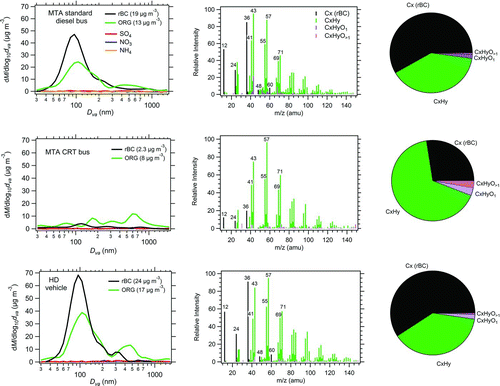Figures & data
FIG. 1 Map of the study area for the mobile measurements of 28 July (0430–0845, EDT) and 31 July (0430–0630, EDT) 2009. On both days, winds were light (<2 m s−1) and coming from S-SW. AML was driven alternatively on the upwind (south) and downwind (north) of the LIE following a raster driving pattern. The QC site is located 450 m south of the LIE.
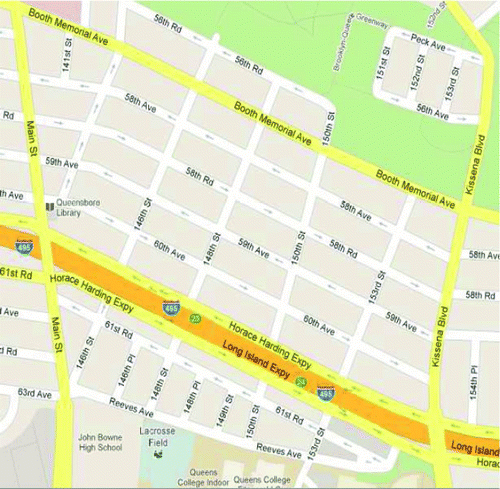
FIG. 2 Spatial and temporal concentration gradients of (a) CO2, (b) NO, and (c) NO2 measured both downwind and upwind of the LIE (right and left column, respectively). Lower pollution levels and no systematic trends characterize the upwind side of the highway. NO2 shows a flat spatial trend, but increases after 0800 EDT. The error bars are the 1-σ standard deviation of data collected on both 28 and 31 July 2009.

FIG. 3 Spatial and temporal concentration gradients of (a) particle number, (b) BC, and (c) ω reported for both the downwind and upwind side of the LIE (right and left column, respectively). The ω values are as low as 0.5 near the LIE. The trends of particle number and BC are qualitatively similar to those observed for CO2 and NO, indicating that the LIE is the common source of these pollutants in the neighborhood. The error bars are the 1 – σ standard deviation of data collected on both 28 July and 31 July 2009.
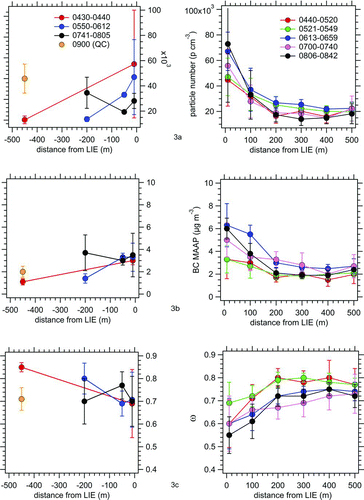
FIG. 4 Results of the PMF analyses performed on the mobile SP-AMS data (combined ORG and rBC matrices) of 28 July 2009, 0430–0845 EDT. Mass-spectra and mass-weighted pie charts, colored by ion families, are shown for HOA + rBC and OOA + rBC. rBC is mostly associated with HOA-like aerosol. The HOA + rBC coating mass is dominated by CxHy ions whereas the OOA + rBC coating mass is equally split among the CxHy, CxHyO1, and CxHyO>1 ion families.
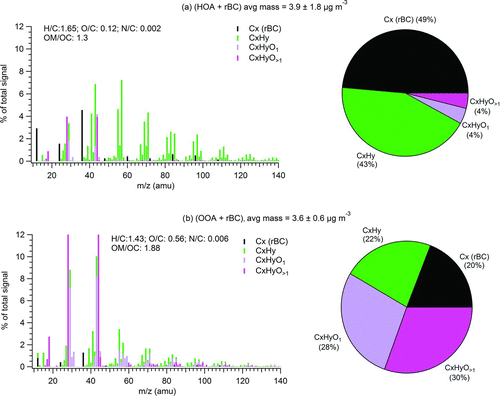
TABLE 1 The r 2 obtained between the SP-AMS based PMF factors HOA + rBC and OOA + rBC and external tracers for the gradient measurements of 28 July 2009
FIG. 5 Spatial-temporal gradients of HOA + rBC and OOA + rBC. HOA + rBC has the a similar trend as the other traffic related species (NO, rBC, CO2), whereas OOA + rBC trends are flat. The ratio between the two factors suggests that HOA + rBC dominates PM1 directly downwind of the LIE (<200 m), whereas OOA + rBC is not directly associated with traffic and it is present in background PM.

FIG. 6 (a) Correlation plot of SP-AMS rBC and MAAP BC for the QC site data (black) and gradient measurements of 28 July and 31 July 2009 (grey). The average regression slope of the fit to the data (0.109) defines the SP-AMS CE for the QC study. (b) Correlation between SP-AMS HOA (with CE applied) and HR-AMS HOA measurements at the QC site. The fit to the data indicates that most of the HOA (80%) is associated with rBC.
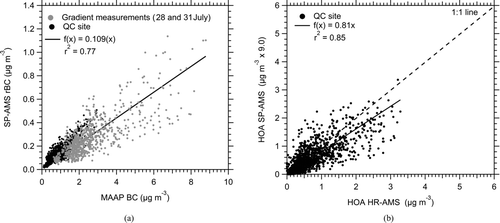
FIG. 7 Chemically resolved, mass normalized pToF size distributions and composition pie charts for (a) the gradient measurements downwind and upwind of the LIE on 28 July 2009 (04:30–08:45 EDT) and (b) SP-AMS measurements at the QC site (upwind of the LIE). The pToF size distributions of HOA and OOA (from m/z 44 and m/z 57 tracers normalized to HOA and OOA mass, respectively) are also shown. The rBC mass is concentrated around D va ∼ 100 nm (“fresh soot” mode). HOA dominates the 500 nm D va mode downwind of the LIE. Under S-SW winds, the pToF at the QC site is dominated by accumulation mode ORG (mainly OOA) and SO4 coatings. The pToF traces are smoothed using binomial algorithm.

FIG. 8 Chemically resolved pToFs, high resolution mass spectra (MS), and mass-weighted composition pie charts of single vehicle emissions sampled in “chase” mode, for a standard diesel engine MTA bus, a CRT bus and a HD vehicle (diesel truck). The contribution of the background aerosol has been subtracted from both pToF and MS. The average mass loadings of rBC and ORG are reported. The pToF traces are normalized to mass and smoothed using a binomial algorithm. The rBC mode is centered at ∼100 nm D va . The emissions from the diesel MTA bus and HD vehicle are dominated by rBC, whereas the CRT bus has higher amount of ORG coating relative to rBC mass. All MS are typical of an HOA aerosol.
